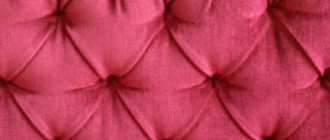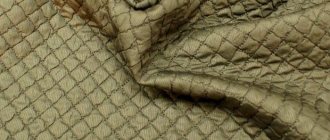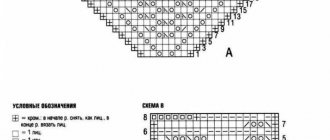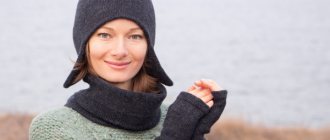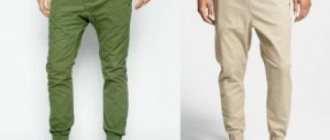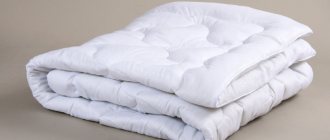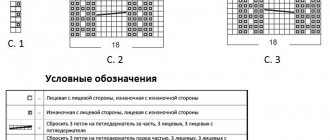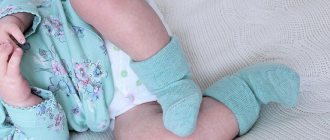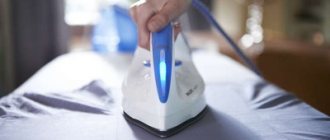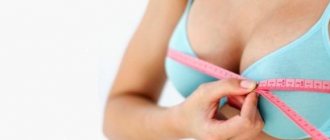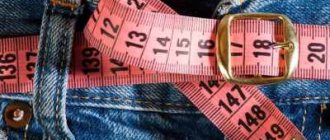One of the best materials is sheep wool. It was available to our distant ancestors. Wool has special qualities; it has not yet been possible to recreate its artificial analogue. Woolen items are wear-resistant and very warm, they retain their attractive appearance for a long time and breathe. It is believed that they can even fight high blood pressure, insomnia and nervous system disorders.
On the eve of cold weather, it would be a good idea to remember woolen items and add them to your wardrobe. But in order for a dress, coat or skirt to serve you for a long time, you should pay attention to what kind of wool they are made of. Look for the word virginwool on the product label. Some call this material the wool of a virgin sheep, and others call it the wool of a lamb. Let's figure out what it really is and what properties it has. Along the way, we’ll find out consumer reviews and what the price of products made from Virginia wool is.
Sheep wool (Wool)
Any wool is a natural fiber. Man began to shear it from sheep more than five thousand years ago. Sheep wool is the most common; products made from camel wool, angora, and alpaca are less commonly found on sale. It is quite durable and hygroscopic. There are several types of sheep wool:
- Lambswool is wool obtained from lambs aged 7-8 months. It is characterized by softness, elasticity, resilience and flexibility.
- Merino wool. Sheared from Merino sheep, it is soft and light.
- Shetland is a coarser wool with high wear resistance, it is sheared from sheep raised in the Shetland Islands (Scotland).
- Cheviot is the wool of another Scottish breed of sheep. Expensive material, characterized by durability and high thermal insulation properties.
Comparison with other species
Wool textiles are divided according to types and characteristics, and are made from camel, goat, merino, llama fiber:
- Cashmere. The most delicate cashmere fiber from Tibetan goats.
- Alpaca. The wool of this animal is especially durable and 7 times warmer than sheep's.
- Lama. The raw material is somewhat tougher, the undercoat is softer.
- Angora. Rabbit down is used in mixed fabrics and requires special careful care.
- Merino. It is distinguished by elasticity, softness and thinness.
- Camel. Comb out the undercoat, delicate and light fluff. The quality of camel down is stiffer than sheep fiber.
- Mohair. From the fluff of Angora goats. The fibers are quite long and have a beautiful shine.
Wool processing
The idea of industrial wool processing is now alien to society. If you walk into any department store and look at the piles of sweaters and dresses in a rainbow of colors, you are unlikely to find items made from Virginia wool, the properties of which are touted by manufacturers, but at the same time, there is not a single recycled fiber in them. However, this was not always the case.
The idea of wool processing arose during the Second World War. The war years influenced fashion. Governments in many countries limited the amount of fabric that could be used to make new clothes. Wool was needed for uniforms. Instead of buying new clothes, people were forced to recycle clothes out of necessity. An adult man's sweater was unraveled and turned into children's sweaters, gloves, socks, etc. And there was nothing wrong with that.
Nowadays, wool production has been established, but some people continue to recycle old products. High quality yarns tend to be expensive.
How is virgin wool produced?
The process of making virgin wool begins with a procedure called shearing. Most types of sheep need shearing at least once a year, and sheep farmers can tell when animals are ready for shearing by the amount and fluffiness of their fur.
In some cases, sheep's wool can be sheared by hand with large scissors. However, these days, electric shears are much more commonly used and are much more productive. Unlike some other animals, sheep usually do not resist the shearing process. As long as the sheep is in the correct position and is not spooked by any sudden movements, it can be shorn without any potential harm or injury.
The wool immediately after shearing will be relatively dirty, so it is usually washed or pre-combed before it is separated into straight strands. This cord fiber is then spun into yarn.
Once the wool yarn has been created, it is washed again and then wound onto large spools. In some cases, this wool may be dyed in the same mill where it was spun, but this process may be done after it has been sent to the textile mill. At this stage, before creating the fabric, the wool clothing or home goods manufacturer may add additives to the yarn.
The process of producing recycled wool begins with sorting and cleaning existing wool fabrics. These fabrics are then shredded and these shredded fibers are spun into yarn. In some cases, the color of the original textile can be retained, or recycled wool yarn can be redyed. It is this grinding process that makes recycled wool less stretchable and less desirable in the consumer market.
The process for obtaining virgin wool from lambs is no different from the process used to obtain virgin wool from mature sheep. However, yarn obtained from lambs is much softer than yarn obtained from fibers from mature sheep and can be spun into finer yarns as it has considerable strength.
Difference between Virgin Wool and Wool
You can often find two definitions of Virginia wool. Some sources say that this is wool sheared from a 4-6 month old merino lamb. Its fibers are very thin (20 microns). The wool is collected by hand, about 140 g is collected from each animal. Other sources say that when buying a coat made of Virginia wool, you are purchasing a product from a completely new material, not previously used. However, it is not at all necessary that the wool is collected from lambs; it can also be sheared from adult sheep. The second interpretation option is considered the most correct.
Virgin Wool is wool that has not been previously processed or woven. This material is often used for recycling. This is not surprising, since there is a limited global supply of completely new wool. Products made from it are more expensive compared to products made from regular wool.
The Virgin Wool designation can only be awarded to wool that is shorn from live, healthy sheep.
We study the fabric for coats, or is not everything cool where it says “wool”
Buying a coat is like choosing a car: you can take a penny, or you can take a Toyota. In the first case, it will be only a means of transportation; in the second, it will be an image item that will make its owner stand out from the crowd, indicating his high status. Like the “penny” mentioned above, a cheap coat constantly requires repairs and replacement of parts, giving the owner more trouble than pleasure. Expensive and high-quality outerwear, on the contrary, keeps its shape for years, even with minimal care. Both in choosing a car and in choosing a men's coat, we pay special attention not to the appearance, but to the “filling”: fabric, seams and lining. However, everything is clear with seams and lining: the first should be even and frequent, without protruding threads, the second should be present as a fact (some manufacturers are trying to save money on this detail of the coat) and preferably made of natural fabric. But determining the quality of the base material of a product is not so easy: you need to be meticulous and carefully read the inscriptions on the labels.
Depending on the season, a man's coat can be made of drape, broadcloth, tweed, cashmere, wool, leather or coat fabric (the latter is an intricate mixture of angora, wool and polyamide). But Russian men are so severe that already at +10 they are ready to show off in jackets and shirts, so warm wool and cashmere coats are the most popular among them.
Classic cashmere coat: timeless and fashionable
Cashmere, which many people mistakenly consider to be fine wool, is actually underwool. Surprisingly warm and soft, from special Kashmiri goats. It ranks first in the international classification of wool quality and is designated on the product label as “Reine Schurwolle”.
Models of women's cashmere coats from the PokupkaLux store catalog
A properly selected cashmere coat will always highlight your figure and last for more than one season.
Women's and men's cashmere coats are cheaper to buy online. But keep in mind, a cashmere coat is like a Maybach, hand-assembled in a German factory: expensive, prestigious, jewellery. Sewing one such product requires the undercoat of several dozen goats - hence the high price: often more than 70 thousand rubles. However, it's worth it: cashmere fiber is four times thinner than human hair, which means it makes a coat very light and soft. And given that the wool of these goats has high thermal insulation properties, a cashmere coat will save you from cold in frosty weather, and from overheating in hot weather. You can’t wear such a coat in slush and rain - it’s a shame, just like driving an exclusive Maybach out of the garage. A cashmere coat is a formal option that can be found in the collections of Brunello Cuccinelli, Louis Vuitton, etc.
For daily wear, a coat marked “Schurwolle” is much better - natural wool containing no more than 7% of foreign impurities. Compared to the world of cars, this is a reliable Toyota, which you can use to get to work or to the dacha. This is the choice of those who know the value of money, but are not ready to overpay. "Schurwolle" (German) is also referred to as lana vergine (Italian) or virgin wool (English).
Coats made of wool of the “Schurwolle” class do not become “overgrown” with pills, wrinkle and get dirty a little, and fit perfectly to the figure. This wool is more wear-resistant than cashmere, but no less light and warm. The best European factories use it in their fabric production: Dormeuil, Dugdale Bros, Zegna, Cadena, etc.
Some companies even offer this yarn in several variations. For example, at the famous Italian factory Loro Piana - whose creators are obsessed with finding the best raw materials for their products - three types of wool belong to the “Schurwolle” class:
| 1. Superfine 2. Storm System 3. Rain System | You can find all these designations on the label of a product with the Loro Piana logo, while the sew-in label will indicate 100% lana vergine (virgin wool). |
The first is high-quality “classic” wool. The fabrics created from it are used to sew timeless men's coats from the Teresa Tardia
. The second and third types are a special line of materials for active men who love sports and travel. It is based on the already familiar SuperFine thread, but with an additional Rain System® impregnation system (provides almost complete windproof fabric), and/or a special Storm System® membrane (makes the material windproof).
Models of men's coats made of Loro Piana wool from the PukupkaLux store catalog
The PukupkaLux assortment includes a large selection of styles and a full size chart
The famous Agent 007 is very elegant in real life
Coats made from this wool “for supermen” are also presented by the Teresa Tardia brand and, as one gentleman joked: “in such clothes you feel like agent 007 - elegant in any weather.”
The price of woolen coats made from Schurwolle class yarn in Russian boutiques starts from 70-80 thousand rubles. It’s cheaper in online stores, but only in those that work directly with Italian suppliers. For example, in PukupkaLux you can find a coat from Teresa Tardia for only 50-60 thousand rubles, and if you have time for a sale, it will cost 25-35.
But if on the label of a collar or inner pocket there is material like: “100% Wool”, “Reine Wolle” - by international standards this is low quality wool, and perhaps even wool scrap. A “penny” that you can drive, but that you don’t want to show to your friends.
Designations that you can find on a men's wool coat:
| Foreign designation | Russian translation | What does this mean? |
| 100% Wolle 100% reine Wolle 100% wool | 100% wool Pure wool Wool | This marking is on products containing low-quality or regenerated (obtained by processing wool rags or rags) wool. |
| Schurwolle | Natural wool | Very high quality wool, first used, containing no more than 7% other fibers. |
| 100% new wool or 100% lana vergine or 100% virgin wool | Pure sheared wool | |
| 100% (reine), Reine Schurwolle | 100% pure natural wool | Cashmere, pure (“golden”) wool, which cannot contain more than 0.3% of foreign fibers. |
| Woolmark (picture on label) | Top quality wool fabric | A quality mark awarded by the International Wool Secretariat. Guarantees that the item consists of shorn wool (i.e. that the sheep was not sprayed with anything to make it shed its wool, but was shorn), that the wool was shorn from a living sheep (because a lot of wool is used in the world, shorn from dead animals), and that the wool was first processed (and was not once recycled). In addition, this mark guarantees the consumer that the item will not become matted or lose color when exposed to light and water. |
Read the discussion of the article on the forum
Properties of Virgin Wool
Quite often you can come across a question from buyers about whether Virginia wool is warm or not. Manufacturers claim that products made from it are ideal for daily wear. They do not roll down, fit to the figure, practically do not wrinkle, retain heat well and at the same time are resistant to stains. Such clothes are universal; depending on the thickness of the knitting, you can choose a very warm sweater or coat for the cold season, or a thin jumper for the off-season.
In addition, the products practically do not absorb moisture, but absorb water vapor well. In order to iron such a skirt or sweater, just hang it in a room with high humidity. The wrinkles will disappear.
Synthetic fiber abbreviations
| Marking | Decoding | Compound | Description | Care | |
| AF/EA | The designation “Other fibers” applies to threads of various origins, the amount of which in the fabric is not more than 5% | Group “other fibers” Sonstige fasem Another fiber Autres fibers | Synthetic threads obtained by chemical means: elastane, lycra, spandex based on rubber raw materials; fiber | Elastic yarn used in mixed materials to increase the stretchability of fabrics and achieve optimal fit. Fiber fabrics are soft, pleasant to the touch, retain their shape well, are easy to care for, and durable. Additional fibers in textiles are contained in quantities not exceeding 5% | We recommend washing on a delicate cycle at a temperature not exceeding 40°C using gel detergents. Does not require ironing, in some cases it is acceptable in the “Synthetics” mode on the wrong side of the product |
| E.A. | Other fibers, sometimes elastane Altre fiber Other fibers and also AF | Chemically derived | As mentioned above | Also | |
| RR | PP, but other designations may also occur: PP, PP HO or PP homopolymer (homopolymer), HIPP (highly isotactic homopolymer), PP-X, PP-XMOD (cross-linked polypropylene), PPCP or PP/Co or PP block-copolymer or PP impact copolymer (polypropylene block copolymer, propylene and ethylene block copolymer), PPM | Polypropylene fiber | Synthetic fiber | Technical flexible fabric is used in construction, industry, trade | Does not require special care |
| CF | The term “carbon” in the international standard labels all types of carbonfiber fibers obtained from carbon. In some cases may be designated as (CN) | Carbon Carbon | Continuous filaments of carbon with various binders | Lightweight, durable material made of carbon fibers, used as a technical material. Flexible chemical fabric can be easily sanded, dyed and polished. Initially developed as a material for space needs. Due to its high degree of reliability, it is used in various fields: the manufacture of sports equipment, the automotive industry, the aviation industry, energy, etc. | Carbon fiber coatings are easy to clean: the surface is wiped as needed. In some cases, polish is used. The material is vulnerable to pinpoint impacts and prolonged exposure to UV rays |
| C.L. | In the Russian code system you can find the CLF symbol adopted for polyvinyl chlorides | Chloride fiber, chlorofiber (synthetic fluff) Chlorofibre | The raw material is polyester | The soft, elastic fiber is used as insulation in outerwear and filling for bedding. Retains heat well, has optimal vapor permeability, and does not absorb foreign odors. | The filler is easy to care for: easy to wash on a delicate cycle and dries quickly. Synthetic feather pillows and blankets require periodic shaking |
| CLF | PVC and other designations: PVC (polyvinyl chloride), PVC-P or FPVC (plasticized polyvinyl chloride), PVC-U or RPVC or U-PVC or UPVC (unplasticized), CPVC or PVC-C or PVCC (chlorinated), HMW PVC (high molecular weight ) | Polyvinyl chloride fiber (PVC) Polyvinylchlorid, Polyvinylidenechlorid | Polymer threads obtained through chemical synthesis | Rigid fabric with a high degree of moisture protection. PVC woven material is a multi-layer fabric, the basis of which is made of cotton or synthetic threads coated with vinyl. Resistant to fire. They are used in various fields: the production of insulators, children's toys, pipes, fittings, coatings. Used in medicine and in sewing some types of clothing and bags. Most often used for the production of banners and awnings | Washing PVC fabrics is prohibited. Sedum is removed from dust by wiping the surface. Dry cleaning is not allowed |
| PVC/PVCF | Polyvinyl chloride PVC | Synthetic polymer fiber | Fire-resistant fabrics for technical purposes. They are used in protective equipment, medical products, children's toys, in the manufacture of fire hoses, pipes, fittings and much more. etc. | Does not require special care | |
| VY | Polyvinylchloride fiber | PVC derivative, polymer | Fireproof technical material | ||
| TV | Trivinyl | Modified PVC | Non-flammable practical material | ||
| EL | Labeling options: Polyurethane (JP)Spandex (US)Elastane or spandex (CN) | Elastane Comma Bubber Elastodien Elastodien Elastan Elasthan Elasthanne | Synthetic polyurethane fiber | Elastane is a synthetic polyurethane fiber that is thin, durable and stretchable. Used as a complement to the main threads of the material to add elasticity | Materials with elastane are easy to care for. Washing should be done according to the manufacturer's recommendations. The water temperature should not exceed 40°C. Items made from elastic fabrics do not need ironing |
| P.U. | Known by trade names: lycra, virin (USA), espa, neolan (Japan), spanzel (UK), vorin (Italy) | Polyurethane Poliuretanica Polyurethane Polyurethane | Used as an additional component to increase strength and elasticity | ||
| R.S. | Dorlastan by TM name | Rubber, artificial rubber Rubber artificial | Synthetic latex fiber | It is characterized by high elasticity. Used as additives | |
| FLS | Can be specified as FLOS | Flos Flos | Synthetic analogue of viscose | The fibers are identical in properties to viscose. Provide better air conductivity and increase wear resistance. More often used as a component of mixed materials. Fabrics with floss are silky, smooth, pleasant to the touch | Easy to care for. Wash at a temperature not higher than 40 - 60°C. It is not recommended to use dry cleaning and intensive twisting |
| LY | In Europe they call it “elastane”, in the USA and Canada it’s called “spandex”. | Lycra (spandex) Laychra Laycra | Segmented polyurethane threads, production technology patented by DuPont | Elastic fibers that can stretch up to 200% and return to their original state. Used as additives to change tissue structure | The materials are easy to maintain. The water temperature during washing should not exceed 40°C. Items made from elastic fabrics do not need ironing |
| PA/PAN | Modacrylic yarns can be marked: MAC | Acrylic, sometimes nylon, polyamide Acrilica Polyacrylic Polyacryl Acrylique Acrilico Acrylic | Synthetic fiber acrylic as a replacement for wool | “Artificial wool” is in many ways similar to natural wool, inferior to it in thermal insulation ability. Soft, pleasant to the touch. Unlike natural wool, it does not prick and is not susceptible to damage by pests. | Wash on delicate cycle at 30 – 40°C. Knitted items with acrylic added should be wrung out with care and dried flat. No ironing required |
| MA/RS | Modified acrylic Modacryl Modacrilice, Modacrylin, Modacryl, Modacryliqe | Synthetic yarn from petroleum products | Light transparent fabric, does not burn, does not absorb moisture. Looks and feels like wool | Products are hand washed at 30°C. Unscrewing is not recommended. Dry flat on a horizontal surface | |
| ME | Marking “Meth” is allowed | Metallic, metallized fiber Metal, Metallised, Metall, Metallic | Metallized polymer fibers | Thin fibers made from melted polyester, coated with metal dust or thin strips of foil. Used as decorative additional components in elegant fabrics and for embroidery | Vulnerable to mechanical stress, high temperatures and UV rays |
| M.F. | The full name of the raw material often indicates Micro Fiber - Micro Acrilico | Microfiber | Synthetic microfiber fiber obtained from polyamide and polyester | A soft, thin fiber used to produce short-pile fabrics (height is measured in fractions of a millimeter). Can be used pure or mixed with other yarn. Protects well from wind, has elasticity and wear resistance | Easy to care for. Furniture upholstery needs dry cleaning or professional chemical cleaning. Microfiber clothes are washed on a delicate cycle |
| M.Y. | Designated as MERYL® | Meryl Meryl | Meryl is a patented name for polyamide threads by the Italian company Nylstar | Synthetic fibers with increased wear resistance. Soft, light, pleasant to the touch. Used in the production of different textured materials, knitted fabrics | Wash on delicate cycle at 40°C. You can't iron! |
| RV | Another name is urilon | Polyurea (polyurea) Polycarbamid | Artificial polymer material | It is used in the production of film materials for technical purposes, the manufacture of floors, roofing, etc. | Unpretentious in care, does not tolerate exposure to high temperatures |
| RE | Other markings - Olefin (US) | Polyethylene fiber Polietilen Polyethylene Polietileno | Chemical fiber, polymer | Soft elastic fiber. Used for the manufacture of packaging materials and as technical fabrics | |
| RVT | Triexta (US, for polytrimethylene terephthalate only) | Polybutylene phthalate Polybutylenterephtalat | Crystallizing polymer | Used as structural plastic in the manufacture of technical products | According to manufacturer's recommendations |
| PTFE | Trade names of PTFE: fluoroplastic-4 (Russia); Teflon, halon (USA); Gostaflon TF (Germany); fluon (England); gaflon, soreflon (France); algoflon (Italy) | Fluoroplastic Teflon | Synthetic polymer | Used for impregnation of textile fabrics to impart certain properties | Do not use aggressive agents, powders or chlorine-containing bleaches in care. |
| PL, PES | Other symbols: PE. Trade names: lavsan, terylene, dacron, tetheron, tergal, tesil | Polyester, polyester fiber Polyester, polyester fiber | Polyester synthetic fiber | Gives fabrics dimensional stability. Used in different combinations (cotton, wool) | Fabrics with polyester fibers should be washed on a gentle cycle at low temperatures. Iron from the wrong side, choosing the mode in accordance with the instructions on the tag |
Prices for clothes from Virgin Wool
The cost of a product made from new wool depends on two factors: brand and type. Note that very often natural fiber is supplemented with acrylic, mohair, and cashmere. This affects the cost. Thus, the Snow Queen brand, widely known in the Russian Federation, offers a coat made of Virginia wool with the addition of 20% acrylic and 10% cashmere at a price of about 10-15 thousand rubles. It is intended for spring and autumn. At the same time, the luxury company MELDES sells coats made of 100% young and new wool at a price of 25 thousand rubles.
Prices for sweaters and skirts range from 5,000-10,000 rubles. Again, a lot depends on the manufacturer. Thus, the English brand Strenesse sells a regular jumper made of new wool at a price of about 300 euros.
Raw materials and production process
The fleece used to make Virginia wool is taken from lambs under one year of age. The fibers are collected manually, by plucking the withers, sides and shoulders of the animal, or using a special sheep shearing machine. To obtain ideal material in terms of quality and properties, it is very important that the animal is absolutely healthy at the time of wool collection.
Interesting! From one lamb you can collect no more than 150 g of high-quality raw materials.
The resulting pile is not dyed at the first stage of production, so the yarn has a natural shade. In the future, it is used as a base in the manufacture of fabric. To reduce the cost of products made from this elite material, cotton, linen, silk, cashmere, and polyester are added.
Today, few companies can provide consumers with clothing made from virgin wool. Among them, the most famous is the British company Harris Tweed, as well as the Italian companies Loro Piana and Lanificio Drago.
Wool blankets
What could be better than a soft and warm woolen blanket in the cold autumn and frosty winter? Wrapping yourself up in it, you can save yourself from even the most severe cold. We don’t argue that a blanket made from Virgin Wool is not a cheap pleasure. However, it is so soft and delicate that it is difficult to resist buying it.
For blankets, as for clothing, a mixed material is often used, adding cashmere or acrylic to new wool. One of the best Italian brands is Giudecca. Giudecca blankets are made from lambs wool and cashmere in equal proportions. They are very soft, warm and light. The cost of a product measuring 130x180 cm is about 20-25 thousand rubles.
Thin blankets made from new lamb wool from the Irish company AVOCA will cost a little less. A product measuring 142x183 cm costs 7-8 thousand rubles.
Products made from Virginia wool: customer reviews
Products made from new wool certainly have advantages over those made from recycled materials or synthetic fibers. In reviews, customers note five main qualities of items made from Virginia wool:
- Durability. A coat or sweater will serve you for many years, and at the same time will look like new.
- Quality. Virgin Wool is not cheap, so it makes no sense for careless manufacturers to “get involved” with it. An item created underground by non-professionals, even from good material, is unlikely to attract many buyers. Consumers in their reviews emphasize the high quality of the products in general, from the correct cut, the correct size chart to the selection of threads and accessories.
- Comfort. The wool is very soft and pleasant to the body. Even the most sensitive people and children do not complain that a sweater or dress pricks or becomes electrified. It practically does not wrinkle.
- Easy to clean. Customer reviews of Virginia wool coats say that the products are easy to clean. In addition, due to the fact that the fibers are practically not electrified, dirt does not stick to the item.
- Warm. Coats, sweaters, trousers, gloves, hats, etc. – all these things made from the new wool of young sheep retain heat perfectly. They allow the body to breathe.
Many people say that a Virgin Wool item cannot be cheap by definition. However, they consider such an investment profitable, because the product will last for many years.
How to properly care for fiber products
All items made of woolen fabrics require careful care, then they will retain their best qualities. It is recommended to wash the products after 5-7 wears, without bringing the item to a heavily soiled state. Choose mild detergents designed for cashmere.
Clothes are washed and rinsed by hand in warm water (not higher than +30 degrees).
The washed product is not twisted, the water is allowed to drain and dried flat. When washing in a machine on a delicate cycle, do not use a spin cycle. Knitted items are not ironed; coats and outerwear are ironed on a delicate setting. Read about the characteristics and description of polyamide fabric here.
It is recommended to store things folded in cellophane in a dark place. Coats and suits should not be left on hangers to prevent the items from becoming deformed.
Opposite opinion
Nowadays, Virginia wool has become a sign of luxury and high cost. However, there is an opinion that this is another attempt to impose certain stereotypes about well-being and fashion on people. This may sound exaggerated, but if you are wearing a sweater or a luxurious suit made from the wool of young lambs, then you are successful and beautiful.
Meanwhile, some people say a piece made from new wool may be worthless compared to something knitted from a $300 sweater that was worn once before being recycled. In their opinion, each buyer decides for himself what “new” means to him.
Fabric composition on the tag
To find out what a wool item is made of, you need to be able to read the label. It contains information about the components of the fabric, the percentage of additives, handling and care methods.
So, what is wool in fabric?
- Wool / lana - sheep's wool. Virgin wool / lana vergine - sheep made from primary raw materials. Lambswool / lana di agnello – obtained from lamb. Merino wool / lana merinos – fine wool from Merino sheep. 100% lana vergine – pure wool without impurities.
If the tag has the Woolmark symbol in the form of a skein of wool, this means that the manufacturer has a license to use the trademark. Production is controlled at all stages, the quality of the fabrics is beyond doubt.
The concept of “Virginia wool” – what is this phenomenon? For many, it sounds like a synonym for luxury and prosperity. A man in an elegant lambswool suit must, by definition, be rich and successful. Perhaps the imposed stereotype is just an attempt at well-organized marketing. Wool-blend clothes, made in compliance with technology, look no less decent.

